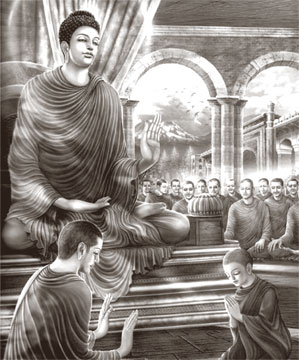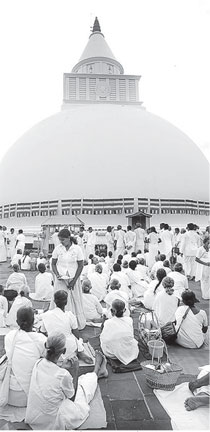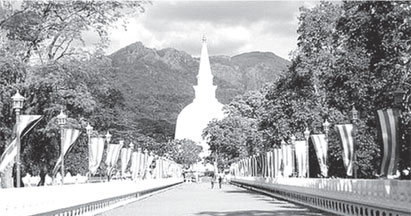Binara Poya marks the beginning of Vas season
By Ananda KANNANGARA
Binara Poya marks the beginning of the Vas season in which Bhikkhus
retreat to temples and engage themselves in numerous activities
including conducting Dhamma sermons, Dhamma discourses and meditation.
They also guide devotees to get involved in various other religious
activities such as Bodhi poojas and Pahan poojas.
 |
|
Queen Mahaprajapathi Gothami calls
upon Ven. Ananda Thera to get the Buddha’s permission to
form the Bhikkhuni Order |
Vas is the only season in which devotees regularly visit temples and
provide the Bhikkhus with four essentials. They are the Cheevara
(robes), Pindapatha (alms), Senasana (shelter) and Gilanupastana
(medicine). Devotees also visit their village temples on other poya
days, such as Vesak, Poson and Esala which are the three main poya days
in the Buddhist calendar.
After Enlightenment under the Bo tree at Buddhagaya, the Buddha
proceeded to Saranath and it was there that He preached His first Dhamma
sermon, the Dhammachakka Pavattana Sutta - to the five ascetics,
Konndanna, Vappa, Baddiya, Mahanama and Assaji in the deer park. The
Buddha revealed the Four Noble Truths to them.
The five ascetics became His first disciples. Many others joined
later. According to ancient chronicles, as soon as the Buddha uttered
the first word, the earth trembled.
The Buddha told His disciples, “Go forth Bhikkhus into the world,
taking the message of the Buddha, explain to them what I have preached”.
The Buddha himself showed the world how one could be of service by
meeting and helping those in distress and suffering in pain. It was out
of loving kindness and compassion that He walked on dusty roads in North
West India preaching His doctrine.
The Buddha’s system was based on His doctrine and discipline that
imply moral excellence and a code of conduct.
The early Bhikkhus depended on the generosity of laymen for their
existence. During the rainy season, the Bhikkhus are confined to the
temple. The rains cause even floods and the roads go under water. The
situation prevents Bhikkhus from going on Pindapatha .
Though the Esala Poya marks the inauguration of the Vas season, it is
continued in the month of Binara when Bhikkhus stay in their temples
without going out for Pindapatha. According to early chronicles, the
first Vas was observed by the Buddha and His five disciples at
Isipathana Migadaya.
Bhikkhuni Order
It was on a Binara Full Moon Poya Day that Queen Mahaprajapathi
Gothami, the stepmother of Prince Siddhartha, visited the Buddha in
Kapilavastu and asked permission to enter the Bhikkhuni Order. The
Buddha refused her request. Although she made the same request again,
the Blessed One did not give His consent.
 |
|
Devotees at a temple on
a poya day |
The Queen then visited Ven. Ananda Thera and requested him to get the
Buddha’s permission to form and enter the Bhikkhuni Order. The queen who
played a lead role to establish the Bhikkhuni Order met Ven. Ananda
Thera with 500 wives of the Sakyan princes with the intention of
entering the Bhikkhuni Order. They shaved their heads and dressed
themselves in yellow robes. They began to weep outside the gate of the
vihara where the Buddha was residing.
Following repeated requests by the queen and the female Sakyans, Ven.
Ananda Thera appealed to the Buddha to grant permission for Queen
Mahaprajapathi Gothami and her 500 companions to enter the Bhikkhuni
Order.
The Buddha considered the request of Mahaprajapathi Gothami and
granted permission to womenfolk to enter the Sasana. This took place on
a Binara Full Moon Poya Day. The Buddha requested the queen and her 500
companions that they should strictly follow and honour eight important
principles (Ashta Garu Dharma) laid down by the Buddha. It was called
the Code of Conduct for Bhikkhunis.
Some of the main Garu Dharmas are as follows:
* A Bhikkhuni, although she had attained the Higher Order even a
hundred years ago, should worship and honour a Bhikkhu who had attained
the Higher Order on that very day (Seniority does not matter).
* No Bhikkhuni should be engaged in retreat in an area where there
are no Bhikkhus.
* Bhikkhunis should always take the advice of Bhikkhus.
* A Bhikkhuni should ceremonially end the retreat in the presence of
both Bhikkhunis and Bhikkhus.
* A novice Bhikkhuni should gain higher ordination before Bhikkhunis
only after one year of study.
* Bhikkhunis should not advise Bhikkhus, although Bhikkhus may advise
Bhikkhunis.
Ven. Ananda Thera told Queen Mahaprajapathi Gothami that the Blessed
One would grant permission to establish the Bhikkhuni Sasana only if she
accepted these conditions.
Conditions accepted
The Queen said that she accepted the conditions laid down by the
Blessed One.
Buddhist history reveals that it was the beginning of the Bhikkhuni
Order. Later, many other womenfolk entered the Bhikkhuni Order. The
Bhikkhuni Order spread fast, not only in many parts of India during the
Buddha era, but also in several other Asian countries including Sri
Lanka.
The Bhikikhuni Order was established in Sri Lanka after the advent of
Buddhism during the period of King Devanampiyatissa. Buddhism was
introduced to the country by Ven. Arahat Mahinda Thera during the period
of King Devanampiyatissa and it was Theri Sangamitta, the sister of Ven.
Mahinda Thera and the daughter of Emperor Asoka of India, who introduced
the Bhikkhuni Order to the country.
Theri Sangamitta not only pioneered the Bhikkhuni Order in the
country, but also brought the Sacred Jayasiri Maha Bo sapling to
Anuradhapura. Even today there are a large number of Bhikkhunis in the
country and they play a major role to propagate Buddhism.
The annual Mahiyangana Vihara Maha Perahara is also conducted on the
Binara Full Moon Poya Day. According to the Mahavamsa, the Sacred Hair
Relics of the Buddha had been enshrined in the Mahiyangana Stupa. When
Deva Mahasumana begged the Buddha for something to worship on His first
visit to the island, the Buddha had given him a handful of hair from His
head.
|
Mahiyangana Raja Maha Vihara

The ancient Mahiyangana Raja Maha Vihara, one of the Solosmastana
(the 16 sacred religious locations in Sri Lanka), is believed to be the
site of Gautama Buddha’s first visit to the island.
Historical sources, including the ancient chronicle Mahavamsa, record
that the Buddha visited Mahiyangana in the ninth month after attaining
Enlightenment. According to the Mahavamsa, Sri Lanka was inhabited by a
tribe called yaksha at the time. The Buddha had subdued the yakshas and
held a discourse on Dhamma with them.
A chieftain named Saman (who is now regarded as a deity) attained the
Sovan state after listening to the Buddha’s discourse, and asked for a
token that could be worshipped in the Buddha’s absence. The Buddha gave
him a handful of hair from his head, which Saman later enshrined in a
small stupa, 10 feet (three metres) in height. This was one of the first
stupas to be built in Sri Lanka.
After the Parinirvana of the Buddha in 543 BC, Arahant Sarabhu is
said to have brought the Buddha’s left clavicle bone, which had been
recovered from the funeral pyre, to Sri Lanka. This relic was also
enshrined within the same stupa, which was enlarged to a height of 18
feet (5.5m). Several kings have since renovated and enlarged the stupa,
including Dutugemunu who raised it to a height of 120 feet (37m). Other
rulers such as Voharika Tissa, Sena II, Vijayabahu I and Kirti Sri
Rajasinha have carried out repairs and maintenance work at the temple.
In 1942, a society was formed for the renovation of the temple under D.
S. Senanayake. Reconstruction work began in 1953 and ended in 1980 with
the completion of a new pinnacle for the stupa. |
|


